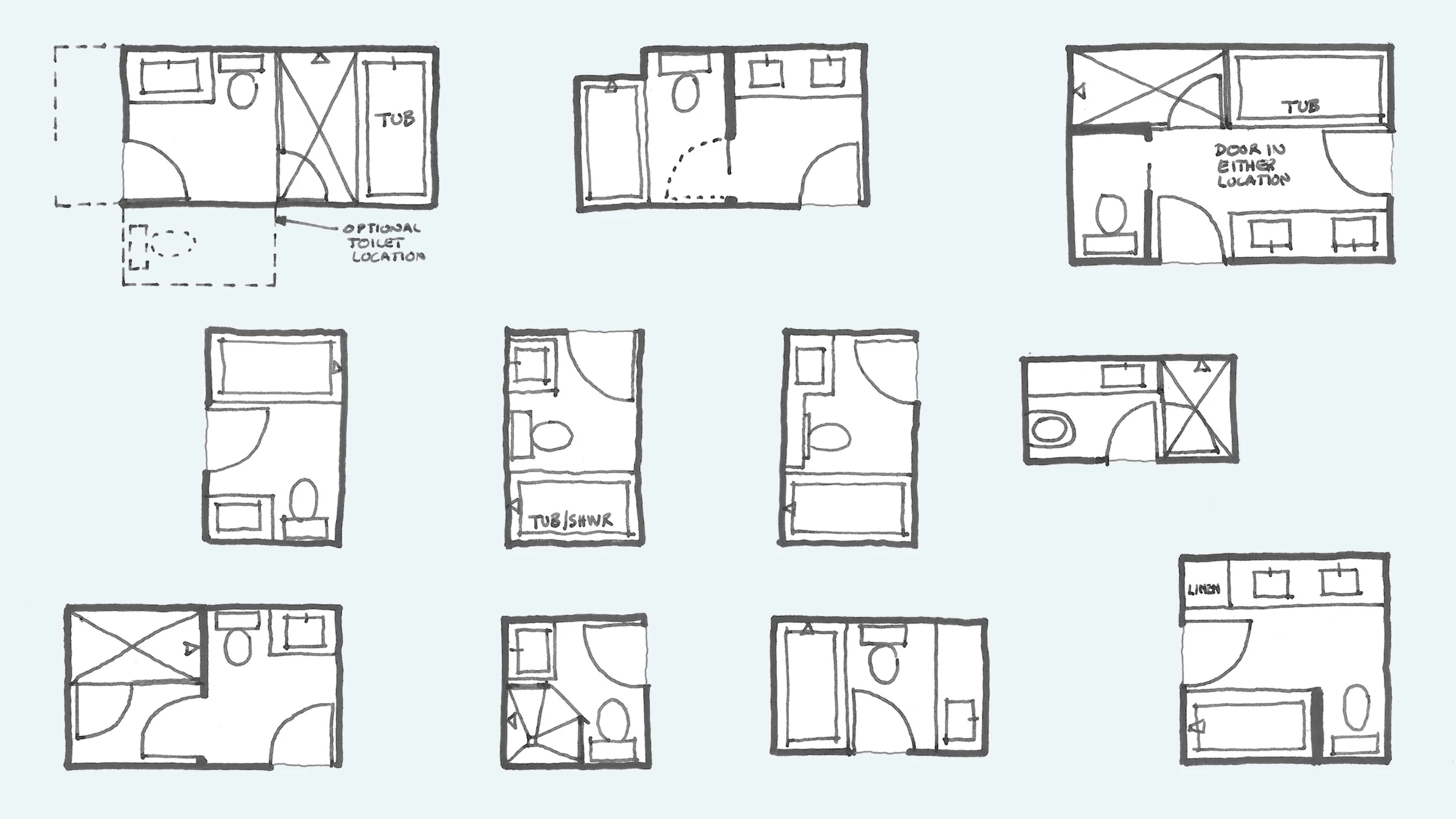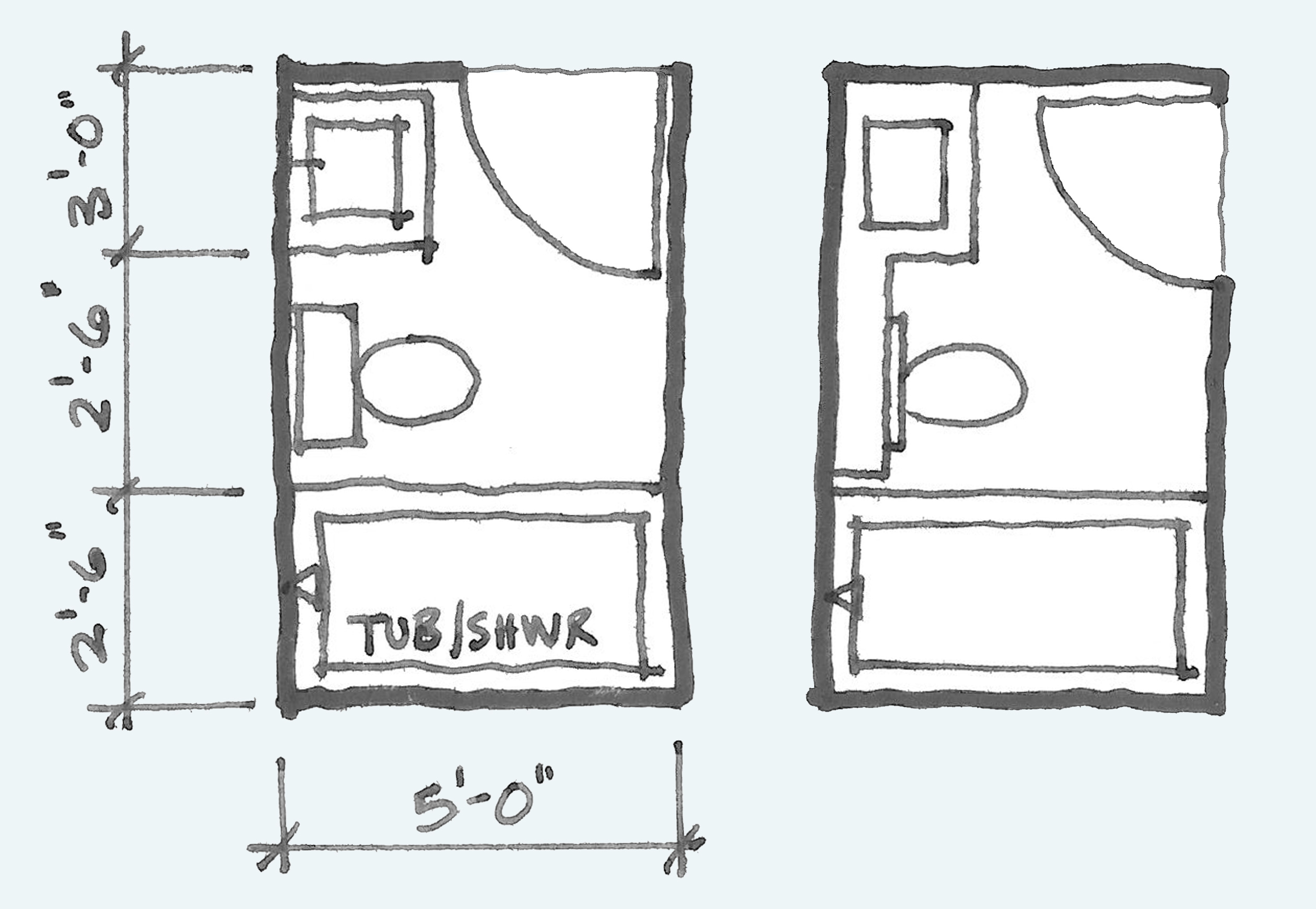Understanding the 6×8 Bathroom Space

A 6×8 bathroom, while compact, presents both challenges and opportunities in design. The limited square footage demands careful planning and creative solutions to maximize functionality and aesthetic appeal.
Impact of Limited Square Footage
A 6×8 bathroom necessitates a thoughtful approach to layout and design. Every inch counts, and the limited space requires careful consideration of the placement of fixtures, storage solutions, and even the selection of materials. The goal is to create a functional and visually appealing space that doesn’t feel cramped.
Different Bathroom Layouts for a 6×8 Space
The limited space of a 6×8 bathroom necessitates a strategic approach to layout. Different configurations offer unique advantages and drawbacks, influencing the overall flow and functionality of the space.
Layout Considerations
- Single-Vanity Layout: A single-vanity layout maximizes space by dedicating the majority of the floor area to the vanity and a larger shower or tub. This layout is ideal for smaller bathrooms where space is at a premium.
- Double-Vanity Layout: While a double-vanity layout might seem luxurious, it can be challenging to accommodate in a 6×8 bathroom. The layout often necessitates a smaller shower or tub to create space for the two vanities.
- Separate Shower and Tub: In a 6×8 bathroom, a separate shower and tub is often impractical. The limited square footage often necessitates a combined shower/tub unit to maximize space.
- Toilet Placement: The toilet placement can significantly impact the overall flow of the bathroom. Placing it near the door can create a sense of congestion, while positioning it in a corner can create a more spacious feel.
Essential Bathroom Features and Functionality: 6 By 8 Bathroom Floor Plan

A 6×8 bathroom, while compact, can be designed to accommodate all the essential features you need for a comfortable and functional space. The key lies in strategic planning and maximizing every inch of available area.
Layout Planning and Functionality
Creating a functional bathroom layout involves carefully considering the placement of key fixtures, like the toilet, sink, shower, and storage. These elements need to be positioned in a way that allows for ease of movement and access while ensuring a comfortable and efficient experience. A well-planned layout ensures that the bathroom is both practical and aesthetically pleasing.
- Toilet Placement: The toilet is typically positioned against a wall, preferably near a plumbing vent. Consider placing it near a window for natural ventilation. In a 6×8 bathroom, placing the toilet in a corner can free up valuable floor space.
- Sink Location: The sink should be positioned close to the toilet for easy access and to minimize plumbing runs. Consider a pedestal sink or a wall-mounted sink to save space. A vanity with storage can be a practical choice, but ensure it is not too large for the room.
- Shower or Bathtub Placement: The shower or bathtub should be placed in a corner or against a wall to optimize space. A shower stall can be more space-efficient than a bathtub, especially in a small bathroom. However, if you prefer a bathtub, consider a smaller model or a soaking tub that fits snugly in the corner.
- Storage Solutions: Storage is essential in any bathroom, especially in a small one. Consider using wall-mounted shelves, cabinets under the sink, or a small linen closet to keep your bathroom organized. A medicine cabinet above the sink can provide additional storage space for toiletries and medications.
Incorporating a Bathtub or Walk-in Shower
Choosing between a bathtub and a walk-in shower depends on personal preference and lifestyle. While a bathtub offers a relaxing soaking experience, a walk-in shower is often preferred for its accessibility and ease of use.
Bathtub Design Tips
A corner bathtub can be a space-saving solution for a 6×8 bathroom. Choose a smaller model or a soaking tub that fits snugly in the corner, maximizing floor space.
- Corner Bathtubs: Corner bathtubs are ideal for maximizing space in a small bathroom. They fit snugly in the corner, leaving more room for other fixtures and movement.
- Compact Models: Choose a bathtub with a compact design to avoid taking up too much floor space. A shorter tub can be just as comfortable for soaking.
- Minimalist Design: Opt for a bathtub with a minimalist design that doesn’t overwhelm the small space. Clean lines and a simple silhouette can make the bathroom feel larger.
Walk-in Shower Design Tips
A walk-in shower is a popular choice for smaller bathrooms, offering easy access and a spacious feel. Consider a glass enclosure to create an open and airy atmosphere.
- Glass Enclosures: Glass enclosures for walk-in showers create an open and airy feel, making the bathroom appear larger. Frameless enclosures offer a sleek and modern aesthetic.
- Space-Saving Features: Consider using a small shower head or a rain shower head to save space and create a luxurious showering experience. A handheld showerhead can be a versatile option, allowing you to adjust the water flow and direction.
- Integrated Storage: Install built-in shelves or niches within the shower enclosure for storage of shampoos, soaps, and other toiletries.
Style and Aesthetics
In a small bathroom, every design decision counts. Aesthetics go beyond just looking good; they contribute to the overall feel and functionality of the space. A well-designed 6×8 bathroom can feel spacious, luxurious, and calming, even with limited square footage.
Mood Board: Visualizing Styles
A mood board serves as a visual guide, showcasing various bathroom styles that work well in a 6×8 space. This helps you envision different possibilities and identify elements that resonate with your taste.
- Modern Minimalism: This style emphasizes clean lines, neutral colors, and sleek fixtures. Think white subway tiles, chrome accents, and a floating vanity. A minimalist approach maximizes the feeling of spaciousness. The use of natural materials like wood and stone adds warmth and texture. A large mirror reflects light, making the space feel larger.
- Rustic Charm: Warm wood tones, distressed finishes, and natural textures create a cozy and inviting atmosphere. Think reclaimed wood vanity, exposed brick accents, and vintage-inspired lighting. A rustic style can bring a touch of the outdoors in, making the bathroom feel more connected to nature.
- Spa-Inspired Serenity: Create a calming oasis with soft colors, natural materials, and calming lighting. Think light blues, greens, and creams, paired with bamboo accents, stone floors, and a freestanding bathtub. Dimmable lighting and soft textures contribute to a relaxing ambiance.
- Contemporary Chic: Bold colors, geometric patterns, and statement pieces define this style. Think black and white tiles, a bold accent wall, and modern lighting fixtures. A contemporary style can add a touch of drama and personality to a small bathroom.
Color Palette: Setting the Mood
Color plays a crucial role in creating the desired aesthetic. In a small bathroom, lighter colors make the space feel larger and brighter. Darker colors can add drama and sophistication but should be used sparingly.
- Light and Airy: White, cream, light gray, and soft pastels create a sense of openness and spaciousness.
- Warm and Inviting: Earthy tones like beige, brown, and terracotta bring a cozy and natural feel.
- Sophisticated and Chic: Black, navy, charcoal, and deep jewel tones add a touch of luxury and drama.
- Calming and Relaxing: Blues, greens, and lavenders evoke a sense of tranquility and serenity.
Lighting: Enhancing the Atmosphere, 6 by 8 bathroom floor plan
Lighting can significantly impact the mood and functionality of a bathroom. Proper lighting is essential for tasks like grooming and applying makeup.
- Natural Light: Maximize natural light by keeping windows clear and using light-colored window treatments.
- Layered Lighting: Combine overhead lighting with task lighting and accent lighting. Overhead lighting provides general illumination, while task lighting illuminates specific areas like the vanity and shower. Accent lighting highlights features like artwork or a statement mirror.
- Dimmable Lighting: Dimmable lighting allows you to adjust the mood and create a relaxing ambiance for evening baths.
Materials: Creating Texture and Style
The materials you choose for your bathroom can significantly influence the overall aesthetic and functionality.
- Tile: Tile is a durable and versatile material that comes in a wide range of colors, patterns, and textures.
- Stone: Stone adds a touch of luxury and natural beauty to a bathroom.
- Wood: Wood brings warmth and texture to a bathroom. Use wood for vanities, cabinets, and flooring.
- Metal: Metal accents add a touch of sophistication and can be used for fixtures, hardware, and accessories.
Successful Bathroom Designs: Inspiration from Real Examples
Many beautifully designed bathrooms fit within a 6×8 footprint. Here are some examples:
- Small Bathroom with a Walk-in Shower: This design features a spacious walk-in shower with a sleek glass enclosure, maximizing space and creating a luxurious feel. The vanity is compact but functional, with a large mirror to reflect light and create a sense of openness. The tile choices are light and airy, enhancing the feeling of spaciousness.
- Compact Bathroom with a Clawfoot Tub: This design features a classic clawfoot tub, adding a touch of elegance and charm. The vanity is kept minimal, with a streamlined design that doesn’t take up too much space. The color palette is neutral and calming, creating a relaxing atmosphere.
- Small Bathroom with a Corner Shower: This design maximizes space by utilizing a corner shower enclosure. The vanity is positioned along one wall, leaving ample space for movement. The tile choices are bold and modern, adding a touch of personality to the space.
